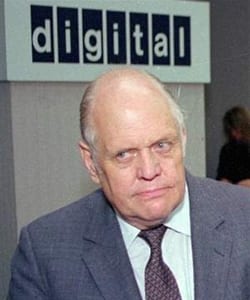By: Chuck Frey
At one time, Digital Equipment Corporation (DEC) was one of the most innovative companies on the planet. What happened?
Ken Olsen, the founder of Digital Equipment Company (DEC) and one of the great entrepreneurs of our lifetime passed away earlier in the week at the age of 84.
Since its founding in 1957 and for most of its 40 year history, DEC was considered one of the great innovative success stories. At its inception, DEC became the first computer company to be funded primarily with venture capital money. A $70,000 investment by American Research and Development Corporation (AR&D) allowed Olsen and his two partners to begin operations in a Civil War era textile mill in Maynard, Massachusetts.
Their business plan was remarkably simple. The fledgling company outlined a two-phase road to profitability. The first phase involved manufacturing computer modules which were simply a selection of independent electronic circuits that were packaged into a circuit board needed at the time for basic functionality of computers. If the company could successfully execute the first phase and show a profit, then phase two would involve the development of a complete computer based on these same modules. For those who want to view this simple but wildly successful plan, it can be viewed here.
DEC’s history of innovation
Among the company’s accomplishments
- DEC machines were the first to use the C language and Unix operating system
- The Vax computer – one of the most popular computers of its time – was the first to use a pure 64-bit microprocessor architecture
- In the 1980s, VAX computers formed one of the first peer-to-peer networks that included email, file sharing, and distributed collaborative projects – all functions that are taken for granted today, but were true innovations at the time.
- DEC was one of the first companies to connect to the internet in 1985; one of the first to use the .com domain; and in 1993, DEC was the first computer company to open a public website.
At its peak in the late-1980s, DEC had $14 billion in sales and grew to more than 125,000 employees with operations in 95 countries. The firm’s market value reached $21.6 billion with the company climbing to number 30 of Fortune magazine’s annual listing of the largest U.S. industrial corporations. And Olsen himself was recognized for his leadership prowess by being proclaimed “America’s most successful entrepreneur” by Fortune magazine.
While DEC was generally considered to be the leader in technology, it also had the best sales force in the business and some of the best marketing folks (think Apple today) around. Most of this a direct result of Ken Olsen’s leadership. Again, to take the Apple analogy one step further, by today’s standards, Ken Olsen would have been considered the “Steve Jobs of his time”.
So where is DEC today?
Through a series of bad bets–most notably DEC’s reluctance to embrace the market potential of personal computers, DEC found itself quickly falling behind its rivals as it entered the 1990s and was unable to catch-up. When IBM faced similar challenges during the same period, IBM was able to successfully pivot its business model by embracing business services. DEC didn’t have the same fortune. In June 1992, Ken Olsen was replaced as the company’s president. The change in leadership showed no real effect; the company continued to lose market share and revenue continued to drop. DEC, which had boosted for years that they never had a general layoff, began to downsize its workforce on an almost annual basis just to stay afloat.
After a number of spinoffs to raise cash during the mid to late 1990s couldn’t slow its decline, DEC was finally put out of its misery and sold to Compaq in January 1998. A very sad ending to what was considered one of the great innovative companies of all-time.
Conclusion
Here’s the takeaway: Great technology never overcomes poor strategy. Despite the brilliance of Ken Olsen and the technological advantage that DEC possessed over its rivals, the company could not overcome the changing market forces of 1990s. At a time where IBM and Microsoft and Intel were all able to adapt, DEC was unable. And in a “Darwin-like” swiftness, DEC became the dinosaur in a world where the PC was the oncoming meteor.

